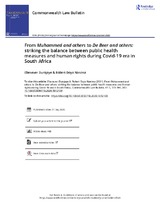| dc.contributor.author | Durojaye, Ebenezer | |
| dc.contributor.author | Nanima, Robert Doya | |
| dc.date.accessioned | 2021-05-31T08:18:44Z | |
| dc.date.available | 2021-05-31T08:18:44Z | |
| dc.date.issued | 2020 | |
| dc.identifier.citation | Ebenezer Durojaye & Robert Doya Nanima (2021) From Muhammed and others to De Beer and others: striking the balance between public health measures and human rights during Covid-19 era in South Africa, Commonwealth Law Bulletin, 47:1, 175-194, DOI: 10.1080/03050718.2020.1812100 | en_US |
| dc.identifier.uri | http://hdl.handle.net/10566/6220 | |
| dc.description.abstract | The world first got to know of coronavirus (Covid 19) in December 2019, when it
rampaged the Chinese city of Wuhan causing many deaths. On 30 January 2020,
the World Health Organisation (WHO) declared the outbreak of COVID-19 to be
a Public Health Emergency of International Concern. About two months later, on
11 March 2020 the WHO recognised it as a pandemic. As at 15 May 2020, over 4
million people had been infected, with over 300,000 deaths.1
The first reported case of Covid-19 in South Africa was made known on 5
March 2020, since then the pandemic has risen drastically with about 14,000
infected, 257 deaths and over 6000 recoveries as at 15 May 2020.2 Thereafter, the
government has adopted several measures to contain the pandemic. This has
enabled it to have an integrated and coordinated disaster management mechanism
that focuses on preventing and reducing the outbreak of the pandemic. | en_US |
| dc.language.iso | en | en_US |
| dc.subject | Covid 19 | en_US |
| dc.subject | World Health Organization (WHO) | en_US |
| dc.subject | Pandemic | en_US |
| dc.subject | Disaster management act | en_US |
| dc.subject | Government | en_US |
| dc.title | From Muhammed and others to De Beer and others: striking the balance between public health measures and human rights during Covid-19 era in South Africa | en_US |
| dc.type | Article | en_US |

